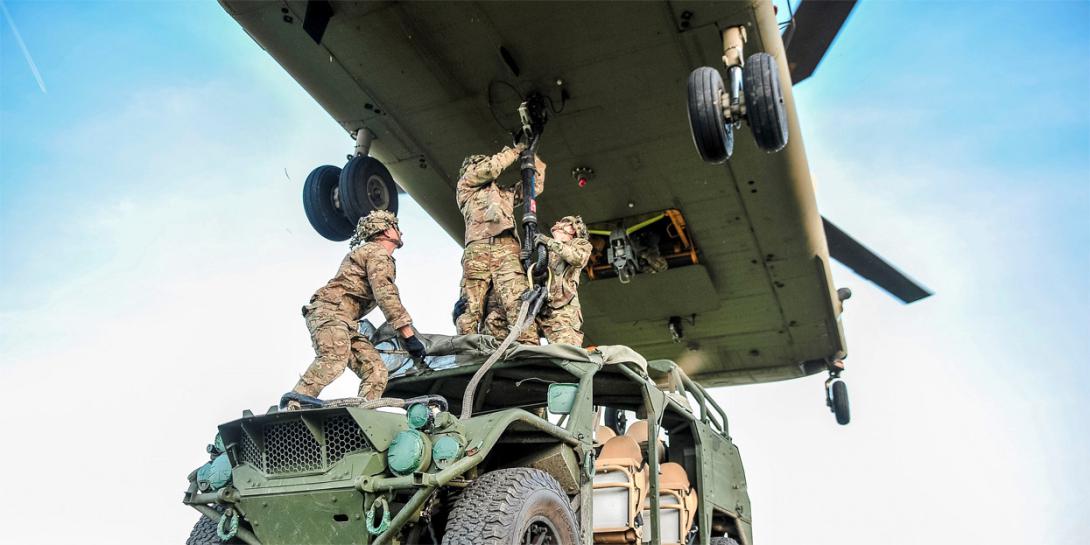Army Invests Heavily in Multidomain Operations
The U.S. Army is committing to the multidomain operations (MDO) concept with a $700 million budget plan for fiscal years 2021-2025. The investment includes cyber, cloud and information warfare.
“Multidomain operations is our fighting concept, and it serves as the foundation of the Army Modernization Strategy. The MDO is how the Army supports the joint force in the rapid and continuous integration across all domains of warfare—land, sea, air, space and cyberspace—to ultimately deter, and win the fight should deterrence fail,” Army Secretary Ryan McCarthy told the audience at the Association of the United States Army annual conference in Washington, D.C.
The investment will help “move the Army from the industrial age processes to the information age leveraging data as a strategic asset and utilizing private sector technology,” he said.
“We invest now or face the delta between capability and threat in which our forces must close the distance at the cost of blood and treasure,” he added. “Russia and, especially China, are on a trajectory to surpass U.S. capability. Both seek to modernize, to man and gain overmatch against the U.S. and our allies. Either you have a sense of urgency today… or a sense of regret tomorrow.”
The Army secretary reported that MDO information operations already are yielding results in Afghanistan. “The right message, at the right time, to the right people, is the crux of MDO Information Operations and it is yielding results at the street level in Afghanistan like we have not seen in 18 years. If low-tech adversaries are able to execute offensive operations in the virtual domain, imagine what the great power competitors are able to launch against us.”
He cited a recent operation in which joint and partner forces countered disinformation from the Taliban. “The adversary’s claims of a tactical victory and towns under siege were quickly disproven through timely, truthful and targeted messaging. The public could see for themselves local officials and partner leaders walking through the village square in real time, via social media. A swift calm ensued in neighboring towns. The enemy, defeated in both reality and in their online narrative, fell silent again.”
The benefits of MDO include the ability to rapidly build joint formations that are strategically positioned “to fight and win across all domains, including space and cyberspace,” he said, stressing the importance of big data and network security. “If we do not have a system in place, access to the data becomes our no man’s land.”
He also highlighted the Integrated Visual Augmentation System (IVAS), prototypical goggles being tested by the Army and Marines that combine synthetic training environments with real-world data to boost the readiness. “A system such as this, on target, has the ability to rapidly identify a target, call in air support, deconflict air space and neutralize a threat precisely in seconds,” McCarthy said. “Systems like this mitigate threat to our forces and integrates the joint force where every member is seeing the same sight picture.”
Data, cloud computing and artificial intelligence (AI) algorithms will make a dramatic difference on the future battlefield, he indicated. “Data moving rapidly, paired with AI algorithms, reduces the time span of decisions from minutes down to seconds. And seconds in a firefight feel like an eternity. Seamless access to data in the cloud is the foundation for the entire Army modernization effort,” he offered. “The cloud serves as a system of systems, moving at speed. It’s scalable and brings computational power into the hands of our soldiers. We will manage big data, employ AI-enabled tools in earnest without sacrificing cyber security or resilience.”
Other officials at the event also touted the benefits of MDO. In a joint press conference Lt. Gen. Eric Wesley, USA, deputy commander of Army Futures Command, and Maj. Gen. Michael Fantini, USAF, director, Air Force Warfighting Integration Capability, indicated the two services largely agree on the MDO concept. “I say we do MDO right now. We’ve been doing MDO for any number of years. It’s just a matter of the scale and speed at which we’re doing is with sneakers and yellow stickies. The vision is to pull this together from a ubiquitous perspective,” Gen. Fantini said.
Gen. Wesley said his Air Force colleague was correct in his assessment that the military already does MDO. “The only thing is that we put a stipulation on it that we want to do it rapidly and continuously,” he added. “We agree with the rubric of being able to enable any shooter through any sensor and through any [command and control] node in near real time with appropriate authorities. The Air Force is saying that, and we’re saying that.”





Comments